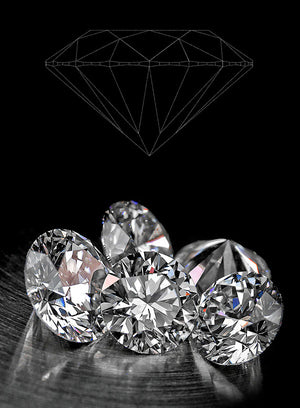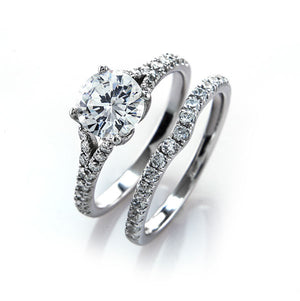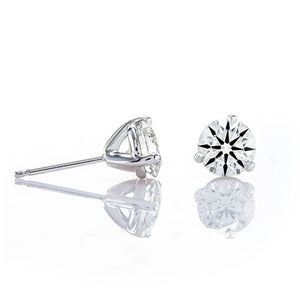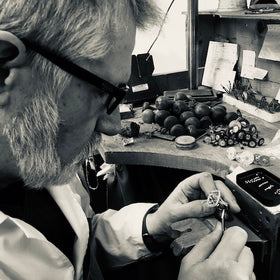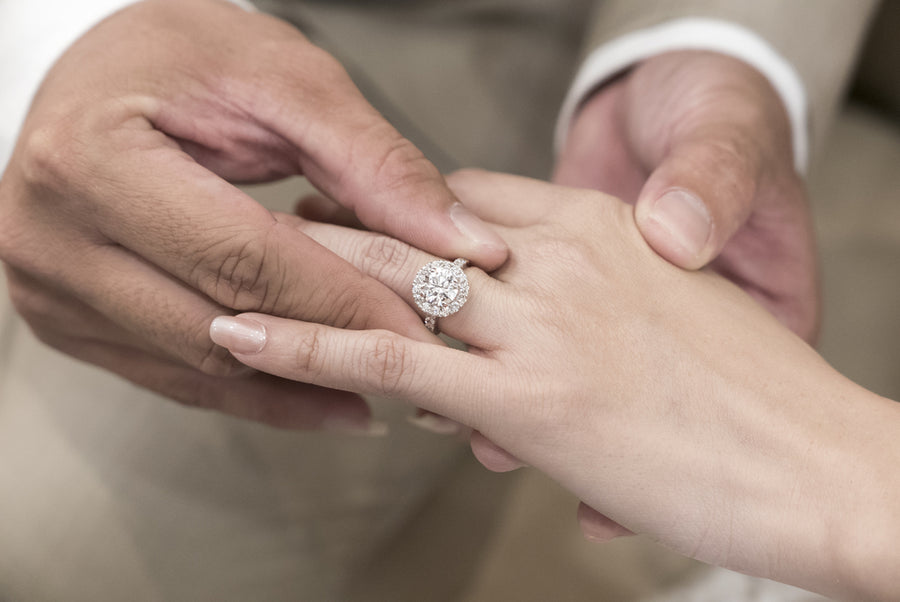
Choosing the Right Lab-Grown Engagement Ring: Can’t-Miss Tips
Getting engaged or preparing for a proposal is an incredibly exciting milestone. Lab-grown diamond engagement rings are becoming more popular in the bridal jewelry market—and considering their beauty, quality, and price, this is no surprise.
However, it can be a confusing process if you’ve never browsed lab-grown diamond engagement rings online. After all—not all lab diamonds are created the same! In this article, we’ll show you what makes Brian Gavin Premium Lab Diamonds stand out from the rest and why we’re so confident one of our diamonds will be the diamond you’ve been searching for.
On this search, you’ll quickly realize there are so many styles of diamond engagement rings—including diamond grades, settings, and metals—to choose from. But all of these options can also prove to be overwhelming.
We’re here to take the overwhelm out of the process and help you shop for the perfect lab-grown engagement ring with confidence.
Read our must-know tips to become an expert on lab diamonds and find the perfect lab-grown diamond engagement ring.
Understanding Lab-Grown Diamonds
Lab-grown diamonds are real diamonds created in a laboratory using a high-pressure, high-temperature (HPHT) lab diamond growing method or a CVD process. They are identical to natural diamonds in chemical composition, visual optics, and physical appearance.
Lab diamonds are popular gemstones in engagement rings because of their durability and brilliance.
Common Questions About Lab-Grown Diamonds For Engagement Rings
Is a Lab-Grown Diamond Okay for an Engagement Ring?
Lab-grown diamonds make great center or accent stones for any engagement ring!
Lab diamonds are increasing in popularity in the diamond and bridal jewelry industries. They look gorgeous in various settings, cuts, and metals and offer great value for your money. They are also more durable than diamond simulants like moissanite or cubic zirconia.
Brian Gavin Diamonds shine brilliantly and look gorgeous in any engagement ring. We follow the GIA scale carefully and inspect each diamond to ensure you get a high-quality diamond that’s cut with precision and offers the carat, clarity, and color you want.
Whether you want our signature Hearts and Arrows diamond or our Brian Gavin Blue line of diamonds, you’re guaranteed a center stone that you’ll fall in love with.
Is it Worth Investing in a Lab-Grown Diamond Engagement Ring?
We believe lab-grown diamond engagement rings and lab-diamond wedding rings are excellent investments for your jewelry collection. They offer a fiery brilliance and have great durability to withstand normal wear and tear.
Lab diamonds will always look great with any outfit! Regardless of the fashion trends that come and go, your lab diamond engagement ring will always be in season. Lab diamonds also come with certifications that attest to their quality. That way, you can be assured your diamond was made with high standards and care.
Can you Tell if an Engagement Ring is Made From Lab Diamonds?
It’s almost impossible to distinguish any differences between the two with your naked eye. Like natural diamonds, the variations and sparkle of the lab-created diamond depend on its individual attributes. Lab diamonds have similar durability, grading scales, quality, and appearance to natural diamonds.
At Brian Gavin Diamonds, we carefully inspect each diamond to ensure it passes our high quality standards. Our lab diamonds have great polish, proportions, and symmetry to shine brightly on your finger.
Will a Lab-Grown Diamond Engagement Ring Last Over Time?
A laboratory-grown diamond has the same hardness and durability as natural diamonds—they will last over time. You can wear your lab diamond engagement ring with confidence and pride while performing your daily activities. Specific settings and metals can make the diamond even more durable.
Can Lab Diamonds Sparkle Like Natural Diamonds?
Lab diamonds have the same appearance and visual optics as natural diamonds. To make sure the lab diamond has the light performance we’re after, we pay close attention to the cut performance of our lab diamonds. After all, this quality is the most critical factor when determining the sparkle factor of your lab diamond and its light performance!
Can You Tell if a Lab Diamond is of Good Quality?
Lab diamonds come with diamond reports to certify the quality of the diamond. Not only should the seller state its stance on quality, but you can also read about the grading of the diamond.
How To Buy A Lab-Grown Diamond Engagement Ring
Here are 11 steps to find the perfect lab-grown diamond ring for yourself or the one you love.
1. Define your Budget
A lab-grown diamond engagement ring is an expensive purchase. So, make sure you plan your budget wisely! Metal, cut, clarity, color, and carat weight will change the price of your engagement ring. You can make adjustments if you go over your budget or if you decide you have more money to work with.
2. Choose Carat Weight
Carat weight usually refers to the total weight of your lab diamond. Larger carat weights will be more expensive than smaller carat weights.
3. Choose Cut
There are several diamond cuts you can choose from. There are brilliant-round cut, princess cut, oval, emerald, marquise, baguette, pear-shaped diamonds, and more. Each shape offers a unique design that can complement different brides.
We carefully inspect our lab-created diamonds to ensure each engagement ring is set with a beautiful stone that you’ll love.
4. Choose Diamond Color
You can have colorless or fancy-colored lab diamonds. Most buyers look for a colorless or near-colorless lab-grown diamond, but you can also go for various colors like red, green, pink, and orange.
Brian Gavin Diamonds offers a range of diamond colors to give your diamond engagement ring a timeless classic look or make it into something fun and unique.
5. Choose a Setting
A solitaire setting is classic, and the simple metal band perfectly highlights the sparkle of the lab-grown diamond.
There are also:
- Halo
- Three-stone
- Pavé
- Fishtail pavé
- and more
6. Choose Metal
Your lab-grown diamond ring can have rose gold, yellow gold, white gold, or platinum metal band. The gold bands come in 14k or 18k gold. 18k gold has more gold content than 14k gold, which makes the metal band appear whiter. However, 14k gold is more durable and scratch resistant.
Platinum rings have a heavier feel and are more durable than gold. This option is great for people who have sensitivities to certain metals. However, keep in mind it also comes with a higher price tag.
7. Size and Shape Availability
Most online sellers have an extensive catalog of lab diamond engagement rings. Certain shapes and sizes might be hard to combine, or might not create the style you want. It’s important to see whether the style of lab-grown engagement ring you want offers the carat weight and shape you want.
You can also speak with one of our expert designers to create the size and shape you want for your lab diamond engagement ring.
8. Learn the 4 Cs (plus 1!) of Diamonds
The four Cs of diamonds are cut, clarity, color, and carat weight. The four Cs help you identify the quality of diamonds, as they are universal standards created by the Gemological Institute of America. Diamonds are typically graded on each of the criteria in the four Cs. You can also find information about the four Cs of the diamond on their lab-grown diamond reports.
At Brian Gavin Diamonds, we use an additional C to measure the quality of the diamonds in our catalog. We inspect each lab diamond carefully based on its cut performance, which refers to the diamond’s symmetry, polish, and proportions. It also refers to how the diamond interacts with light to give a fiery shine.
9. Learn About Lab Diamond Reports
Lab diamonds have certificates with information about their grades based on the four Cs - cut, clarity, color, and carat weight. It also provides other vital information about the lab diamond’s characteristics. The lab diamond report verifies the authenticity and quality of the diamond—read the certificate carefully and only buy lab diamonds with a certified report.
10. Find a Reputable Online Seller
Go to a reputable seller with high-quality standards and many positive reviews from genuine buyers. Avoid scams that seem too good to be true.
11. Take Your Time
Think carefully about the lab diamond engagement ring you want to buy. There are many styles of lab diamonds and many settings and metals you can set your diamond in.
Consider which style of lab-grown diamond engagement ring your bride might like and whether the seller has that style readily available. If you can’t find the style you want, take the time to work closely with one of our designers to make your vision come to life.
Your bride will wear her lab diamond ring for a lifetime. We want it to be an engagement ring you both genuinely love and serves as a fond reminder of your love and commitment to each other.
Brilliant Lab Diamonds Set Into Your Unique Brian Gavin Diamonds Engagement Ring
Now that you’ve read our how-to guide for choosing the perfect lab-grown diamond engagement ring, you should have some knowledge about what to look out for and how to shop for lab diamonds online.
These tips help you make an informed choice about the type of lab diamond and the style of diamond engagement ring you purchase. With Brian Gavin Diamonds, not only will you acquire a dazzling lab diamond ring, but you will also discover a trustworthy seller you can rely on.
Brian Gavin Diamonds pays close attention to quality. Our in-house diamonds are grown using our patent-pending CVD process, ensuring maximum transparency and sparkle. We offer a large selection of diamond engagement rings pre-set into many styles, or you can design a unique engagement ring with the help of our designers.
Each lab-grown diamond is not only cut with precision but also comes with a lab-grown diamond report to certify its grading and quality.
Your next step? Find the lab diamond you want!





